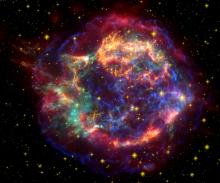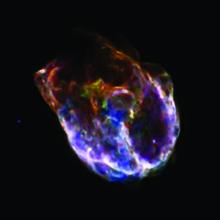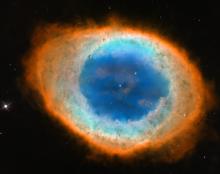Listen to today's episode of StarDate on the web the same day it airs in high-quality streaming audio without any extra ads or announcements. Choose a $8 one-month pass, or listen every day for a year for just $30.
You are here
Oxygen
Oxygen is one of the most important elements on Earth. It makes up about one-fifth of the mass of the atmosphere, nine-tenths of the mass of water, and two-thirds of the mass of the human body. It’s a by-product of plant life, and a necessity for animal life. And it combines with other elements to make everything from water to rocks.
All of the oxygen atoms on Earth — and throughout the universe, for that matter — were made by stars.
When a star is born, it’s made mainly of hydrogen, the simplest chemical element, which was forged in the Big Bang. For most of its life, the star fuses the hydrogen in its core to make helium. At the end of its life, a star as massive as the Sun or heavier fuses the helium to make heavier elements. A star like the Sun makes carbon and oxygen, while heavier stars make even more elements — all the way up to iron.
Over the 14-billion-year history of the universe, stars have made more oxygen than any other element, so it now accounts for about one percent of all the atoms in the universe.
When a star dies, it expels much of its gas into space. Stars like the Sun do so in a fairly gentle process, creating beautiful clouds that eventually dissipate. More massive stars do it more explosively, blasting out debris at a few percent of the speed of light. This mixture of elements can then be incorporated into new stars and planets — and at least in the case of our own Earth, into living organisms as well.
Script by Damond Benningfield





